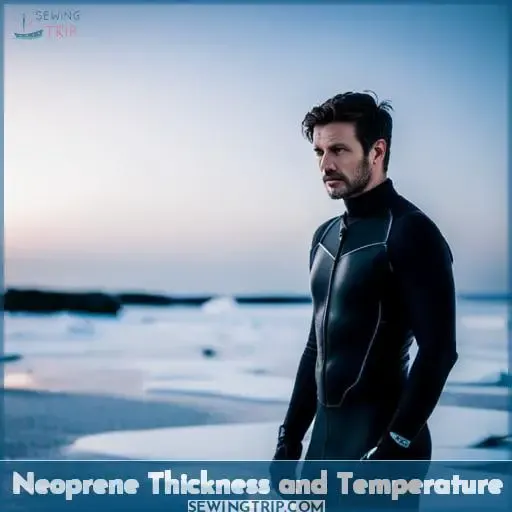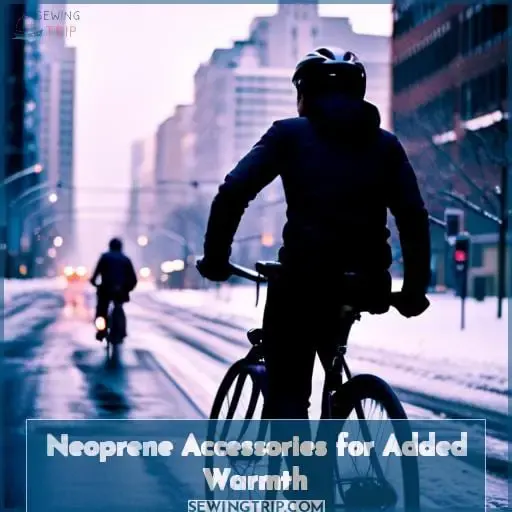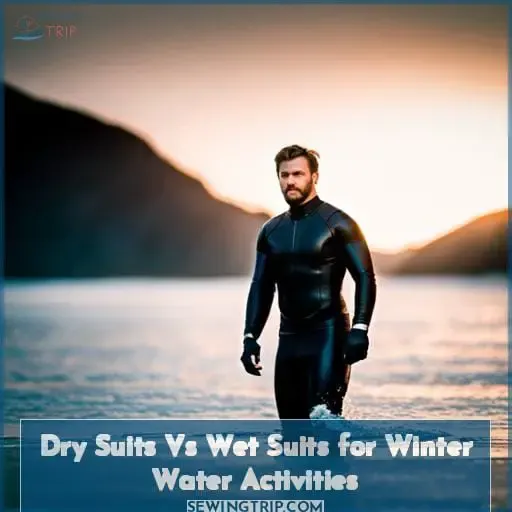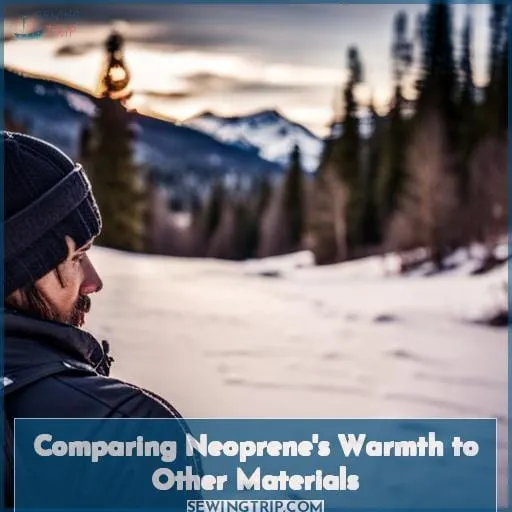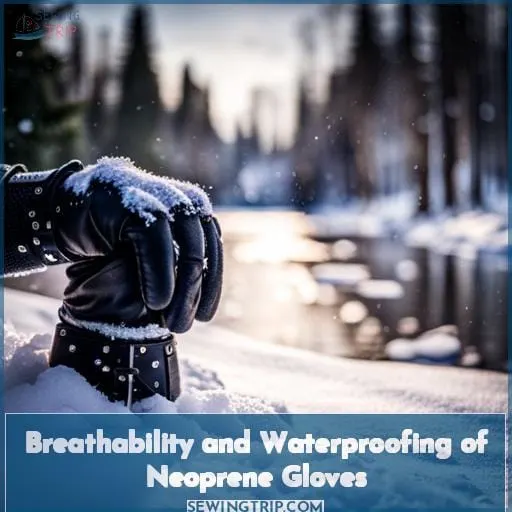This site is supported by our readers. We may earn a commission, at no cost to you, if you purchase through links.
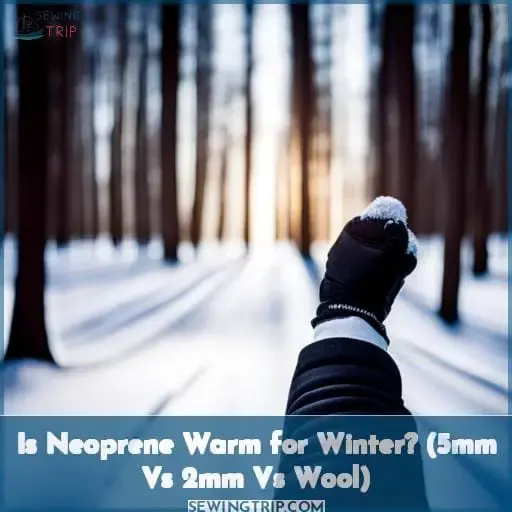 Set sail on a journey to conquer winter’s chill with the ultimate shield: neoprene. When the icy winds start to bite, and the frosty grip of winter tightens, you need a trusty ally to keep you snug and victorious.
Set sail on a journey to conquer winter’s chill with the ultimate shield: neoprene. When the icy winds start to bite, and the frosty grip of winter tightens, you need a trusty ally to keep you snug and victorious.
Whether you’re braving the elements or taking on winter water sports, the question arises: Is neoprene warm enough for winter? Brace yourself as we delve into the world of neoprene, unraveling its thickness secrets (5mm vs.
2mm), its cozy companions like gloves and socks, and the art of maintaining this formidable material.
As you seek liberation from the winter’s icy grasp, neoprene stands ready to empower you, keeping you warm and fearless in the face of the frostiest days.
Table Of Contents
- Key Takeaways
- Is Neoprene Effective for Winter Warmth?
- Neoprene Thickness and Temperature
- Neoprene Accessories for Added Warmth
- Proper Care and Maintenance of Neoprene
- Limitations and Alternatives to Neoprene
- Dry Suits Vs Wet Suits for Winter Water Activities
- Comparing Neoprene’s Warmth to Other Materials
- Selecting the Right Neoprene Fabric for Winter Wear
- Understanding Neoprene and Its Environmental Impact
- Breathability and Waterproofing of Neoprene Gloves
- Frequently Asked Questions (FAQs)
- Conclusion
Key Takeaways
- Neoprene provides winter warmth against cold and icy winds.
- The thickness of neoprene determines its effectiveness for different temperatures.
- Neoprene accessories like gloves and socks enhance winter warmth.
- Neoprene gloves might not be ideal for prolonged daily wear.
Is Neoprene Effective for Winter Warmth?
Embracing the chill, your shield against the elements molds to your body — a vigilant guardian against the season’s icy breath, allowing you to dance with comfort amidst nature’s frozen symphony. Neoprene, a remarkable fabric born from innovation, stands as a formidable contender in the realm of cold weather gear.
When comparing its performance, neoprene’s unique attributes come to light. Its effectiveness in delivering winter warmth hinges on its thickness and your chosen activity. In the realm of water activities, neoprene reigns supreme, providing a reliable barrier against the cold.
Its ability to trap a thin layer of water against your skin acts as a natural insulator, maintaining a cozy microclimate.
However, it’s important to note that neoprene’s breathability is limited, which can lead to moisture buildup during high-intensity endeavors. In such scenarios, alternatives like Thinsulate or wool may offer greater breathability while keeping you warm.
Neoprene’s versatility shines when it comes to accessories. From wind-resistant gloves and liners to insulating socks, it provides an array of options for those seeking to conquer winter’s chill. Yet, for prolonged winter water activities, the breathable and waterproof properties of dry suits emerge as the preferred choice, offering unparalleled comfort and protection.
In your pursuit of liberation, power, and safety amidst the winter’s grasp, remember that neoprene is an invaluable tool in your arsenal. Its ability to shield you from the cold is undeniable, especially when tailored to the right conditions and activities.
So, venture forth, equipped with the knowledge of neoprene’s capabilities, and relish in the triumph over winter’s icy embrace.
Neoprene Thickness and Temperature
Delving into the realm of neoprene’s winter prowess, you’ll find that its effectiveness is closely tied to the factors of thickness and temperature. Imagine this: a 2mm suit for the 62-68°F range, while a 5mm suit protects against the cold in 43-52°F waters, ensuring you remain comfortably snug as you brave the winter’s aquatic embrace.
2mm Neoprene for 62-68°F
Delve into the realm of winter waters with the agility of a seasoned adventurer, as a 2mm shield of resilience envelops you for temperatures spanning 62 to 68°F, ensuring comfort against the brisk aquatic embrace.
Neoprene’s insulating prowess and meticulous wetsuit design merge, granting you the power to conquer the chill. The optimal 2mm thickness strikes a harmonious balance – substantial enough to trap a thin layer of water for insulation while granting you the freedom to move.
Its intelligent engineering offers both warmth and flexibility, crucial for water sports enthusiasts seeking liberation amidst icy splendor.
5mm Neoprene for 43-52°F
With a 5mm thickness, you’re ensuring effective insulation against temperatures ranging from 43 to 52°F – a shield that keeps the chill at bay while you enjoy your cold-weather adventures.
- Wet Suit Design: Crafted for cold water diving, its intelligent construction minimizes heat loss.
- Comparing Thermal Properties: 5mm neoprene outperforms thinner options, trapping a thicker layer of water for superior insulation.
- Flexibility and Mobility: Don’t sacrifice movement for warmth. The 5mm neoprene strikes a balance, providing the necessary flexibility for your dynamic winter activities.
- Neoprene Gloves and Boots: Complete your ensemble with neoprene gloves and boots. They safeguard your extremities, preventing the numbing grasp of cold temperatures.
Whether you’re conquering waves or delving into icy depths, 5mm neoprene stands as your stalwart companion. Its prowess withstands cold waters, empowering your pursuit of liberation, power, and above all, safety.
Neoprene Accessories for Added Warmth
Exploring the realm of added winter warmth with neoprene extends beyond its core use, encompassing an arsenal of accessories. Slip into wind-resistant gloves, embrace the snug comfort of liners and hand warmers, while extra warmth and protective layers of neoprene socks redefine your cold-weather ventures.
Elevate your defense against icy chills through the strategic embrace of layering, a key tactic for amping up the cozy factor in even the coldest conditions.
Gloves: Wind-resistant, Liners, Hand Warmers
Navigate the world of chilly adventures by slipping into wind-resistant gloves that bring comfort to your hands, accompanied by clever liners and ingenious hand warmers to keep you snug during frosty escapades.
With a variety of insulation options available, neoprene gloves provide excellent wind resistance and protection against the cold weather. These gloves are perfect for a range of cold weather activities such as skiing, snowboarding, hiking, or simply taking a walk in a winter wonderland.
Don’t let freezing temperatures hinder your outdoor pursuits – gear up with neoprene accessories for added warmth!
| Wind-Resistant Gloves | Liners | Hand Warmers |
|---|---|---|
| Neoprene material | Soft and cozy | Instant heat |
| Blocks out wind | Moisture-wicking | Long-lasting warmth |
| Retains body heat | Insulating layer |
Stay protected from icy winds while enjoying your favorite winter activities with these versatile neoprene gloves. The soft and cozy liners add an extra layer of insulation, ensuring maximum warmth on those bitterly cold days.
Need some instant heat? Slip in the ingenious hand warmers before heading out into the elements – they will provide long-lasting warmth throughout all your outdoor ventures this winter season.
Socks: Extra Warmth, Protection
Bundle up your feet in these specialized insulating layers, and you’ll be giving winter’s chill the cold shoulder while ensuring your comfort and protection. Neoprene socks bring a fusion of moisture management and insulating technology, keeping your feet dry and warm during cold weather activities.
The material’s durability ensures long-lasting use, making them a reliable choice. Experience optimal thermal regulation as you conquer the winter cold – neoprene socks: warm for winter, extra warmth, and protection combined.
Layering: Added Warmth in Colder Conditions
To enhance insulation in colder settings, exploit the synergy of layering for a robust shield against the cold. Combine neoprene with other materials strategically to maximize warmth while engaging in invigorating winter water activities.
Wetsuit benefits like thermal insulation, coupled with neoprene’s innate warmth, create a dynamic duo. Layering techniques amplify neoprene’s natural insulation, effectively countering the cold weather and catering to your sensitivity to cold.
Experience drysuit comfort with enhanced warmth and revel in liberating, powerful winter exploits.
Proper Care and Maintenance of Neoprene
Delving into the realm of neoprene care, your pathway to sustained winter warmth unfolds through diligent steps. After your ventures in chlorinated waters, a swift rinse rejuvenates your gear, while Gear Aid’s specialized shampoo unveils its prowess.
The ballet of prevention continues as meticulous drying and cleansing waltz together, orchestrating a symphony against mold and mildew, while the encore lies in the artful storage – pristine, dry, poised upon hangers or nestled flat.
Rinsing After Chlorine Exposure, Using Gear Aid’s Shampoo
Explore the rejuvenating effect of rinsing your gear after exposure to chlorine, amplifying its longevity and performance, while Gear Aid’s specialized shampoo ensures that every fiber retains its resilience against the elements.
| Chlorine Effects | Gear Aid Alternatives | Neoprene Durability |
|---|---|---|
| Fading color | Mild soap | Prolonged life |
| Material breakdown | Gentle detergents | Enhanced |
| Weakening fabric | DIY vinegar solution | Resilience |
| Elasticity loss | Wetsuit cleaner | Performance |
| Odor accumulation | Versatility |
Embrace the practice for your neoprene’s winter excellence. Guard against chlorine exposure risks, sustaining its insulation. Elevate your water sports experience with preserved gear, enhancing both your safety and dominance in the cold waves.
Preventing Mold and Mildew Through Thorough Drying and Washing
Ensure your gear remains in top condition by thoroughly drying and washing it after use, preventing the growth of unwanted mold and mildew. Effective drying methods play a pivotal role in maintaining neoprene’s winter-ready capabilities.
Neoprene’s insulation can be compromised if trapped moisture fosters mold. Cleaning procedures further safeguard against this risk. Controlling humidity and promoting adequate ventilation in storage areas contribute significantly to mold prevention.
Proper Storage: Clean, Dry, Hang or Lay Flat
Stash your gear stylishly, suspended or spread, for safe storage and swift retrieval. Neoprene’s winter prowess endures with proper post-use care. Hang it proudly or lay it flat; the choice holds the key.
Drying is the initial ritual – inside and out – to ward off unwelcome odors. Keep it clean, free of sand and grime. A well-ventilated haven ensures long-term durability, preserving neoprene’s winter-ready embrace.
Limitations and Alternatives to Neoprene
Embracing winter’s chill, you seek warmth that adapts – enter neoprene. Yet, while it shields against icy waters, remember its niche: an ally for aquatic pursuits, not your everyday winter armor. Explore alternatives like wool, its snug embrace tailored by type and thickness, or Thinsulate, offering superior warmth and breathability, both challenging neoprene’s supremacy beyond the waves.
Wool: Warmer Based on Type and Thickness
Discover the versatility of wool in optimizing your winter gear for ultimate warmth and comfort during cold-weather activities. Varying textures and thicknesses of different wool types allow tailored insulation.
Embrace the power of wool’s natural insulation, effectively trapping warmth while remaining breathable. Unlike neoprene, wool offers a balance between warmth and breathability. Customize your winter attire with wool’s options, catering to your liberation, power, and safety needs.
Thinsulate: Warmer and More Breathable Than Neoprene
Explore the concept of Thinsulate as it outperforms neoprene in terms of warmth and breathability, offering an enticing alternative for winter activities in chilly conditions.
Thinsulate comparison: Provides superior insulation performance compared to neoprene.
Moisture management: Wicks away sweat, keeping you dry and comfortable during outdoor activities.
Layering options: Allows for easy layering with other clothing items to adapt to changing temperatures.
With its exceptional warmth and breathability, Thinsulate is a fantastic choice for those seeking liberation from the limitations of neoprene. Whether you’re engaging in intense outdoor activities or simply looking to stay warm throughout the winter season, this innovative material allows you to enjoy both power and safety without compromising on comfort.
So why settle for anything less when there’s Thinsulate?
Neoprene Better Suited for Water Activities, Not Daily Winter Wear
For everyday winter wear, consider alternatives like wool or Thinsulate instead of neoprene. These materials excel in warmth and breathability, unlike neoprene designed mainly for water activities. While neoprene offers protection and insulation in wet conditions, it may not provide the same level of comfort for daily use.
Embrace the liberating power of superior alternatives, ensuring warmth, style, and comfort in your winter fashion choices.
Dry Suits Vs Wet Suits for Winter Water Activities
Delving into the realm of winter water activities, the dichotomy between dry suits and wetsuits emerges distinctly. While dry suits entice with their breathability and watertight prowess, they are unequivocally recommended for extended icy escapades.
Conversely, wetsuits unveil their talent in trapping thermal comfort even when drenched, yet their shield against hypothermia remains limited in the face of frigid waters.
Dry Suits: Breathable, Waterproof, Recommended for Prolonged Winter Water Sports
Embrace the advantages of dry suits – they offer breathability and waterproofing, making them the ideal choice for extended cold-water activities.
When winter’s icy grip tightens, your safety and comfort take center stage. Unlike wetsuits that rely on trapped water for insulation, dry suits keep you dry and warm, guarding against the threat of hypothermia.
Neoprene’s limitations fade as you explore this liberating alternative. Layering strategies enhance their warmth, allowing you to tailor protection to your needs.
With neoprene alternatives at your disposal and armed with the power of breathable, waterproof dry suits, you’re free to conquer winter’s challenges in the realm of water, unbound by the cold’s grasp.
Wet Suits: Thermal Insulation When Wet, Limited Protection Against Hypothermia
Bask in the aquatic embrace, where your shield against winter’s icy breath beckons. As you plunge, the very elements conspire against you, yet your armor of choice stands firm, an insulating barrier against the frigid waters.
Hypothermia prevention becomes your silent companion as wet suits embrace you with their strategic design. Crafted from neoprene, these winter wonders boast thermal insulation even when soaked. Their material offers limited protection against hypothermia, wrapping you in warmth amidst the cold depths.
Through clever engineering, they ensure comfort as you brave the water’s chill. Maintenance and care uphold their performance, enabling your aquatic liberation.
Comparing Neoprene’s Warmth to Other Materials
Delving into the realm of winter warmth, you’ll unravel the comparative embrace of Neoprene versus Thinsulate, deciphering which offers a cozier shield. Beyond this, the textured terrain awaits, pitting Neoprene against Wool in a contest of heat retention.
Neoprene Vs Thinsulate: Which is Warmer?
Discovering how different materials stack up in keeping you toasty during chilly months, curiosity peaks over the Thinsulate vs. neoprene comparison. Thinsulate boasts superior breathability and insulation, offering warmth without bulk.
While neoprene excels in water activities, Thinsulate’s moisture management and versatility make it a contender for winter layering.
Neoprene Vs Wool: Which is Warmer?
Delve into the realm of comparison as you explore the insulating prowess of wool in the chill of the season. Wool, a timeless guardian against winter’s embrace, boasts exceptional thermal performance. Its natural fibers create countless pockets of warmth, superior to neoprene’s insulation.
Are Neoprene Boots Warm?
Explore the cozy insulation of these boots, akin to a snug shield against chilly outdoor conditions, as you navigate through the winter months. Neoprene boots offer impressive warmth due to their well-designed thickness variety, water-resistant nature, and effective moisture management.
Whether you’re hiking or strolling, neoprene keeps you confidently warm amidst varying air temperatures.
Do Neoprene Gloves Keep You Warm?
In the realm of winter cold, envision your hands clad in neoprene gloves—an embrace of warmth against biting winds. These gloves, designed with strategic insulation, boast impressive thermal properties that defy extreme conditions.
Your fingers revel in unparalleled mobility, essential for winter activities. Moisture management is their forte, ensuring comfort and safeguarding your winter exploits.
Neoprene gloves are a winter essential. They excel in retaining your hand’s natural warmth, creating a haven of coziness even in icy temperatures. The unrestrictive design grants you full control, letting your fingers dance through tasks and activities.
These gloves are your reliable companions against the harshest elements, enduring snowball fights and frosty adventures. Efficient moisture-wicking battles perspiration and discomfort, a vital attribute for prolonged use.
Whether skiing, hiking, or simply braving the cold, neoprene gloves empower you to seize winter with unwavering confidence.
Selecting the Right Neoprene Fabric for Winter Wear
Navigate the realm of frigid seasons with confidence by choosing the perfect fabric that not only offers you snug comfort, akin to a warm embrace, but also ensures your protection against the harsh elements of winter.
When it comes to braving the cold, neoprene emerges as a top contender for your winter wear.
The selection of neoprene thickness plays a pivotal role in your insulation experience. For milder winter conditions, a 2mm neoprene suit offers coziness, ideal for temperatures between 62°F to 68°F, while a 5mm suit steps up the insulation game, designed for temperatures ranging from 43°F to 52°F.
The trick lies in the fabric’s ingenious ability to trap a thin layer of water close to your body, providing efficient thermal insulation during activities like diving.
Neoprene, with its exceptional wind-resistant properties, stands as a trustworthy companion for outdoor ventures. As you explore various outdoor activities, keep in mind that neoprene’s effectiveness isn’t confined to thickness alone.
The quality of neoprene, often categorized by grades, dictates its durability and overall performance.
While neoprene offers unmatched warmth during water-related pursuits, it’s important to note that its breathability is limited, making it less suitable for everyday winter wear. In situations demanding prolonged exposure to cold water, like winter water sports, dry suits might be your preferred choice due to their breathability and waterproof attributes.
Conclusively, embrace the winter with confidence by selecting the right neoprene fabric that aligns with your outdoor activities. Remember, the key lies in understanding the thickness that suits your needs and the quality of neoprene that ensures longevity.
Understanding Neoprene and Its Environmental Impact
Delving into the realm of Neoprene’s environmental impact unveils intriguing facets: Can Neoprene truly embrace eco-friendliness, or is its breakdown inevitable? Unravel the intricacies as we explore the ecological nuances and the inevitable fate of this versatile material.
Can Neoprene Be Environmentally Friendly?
Delve into the realm of eco-conscious alternatives as you ponder the impact of material choices on both comfort and the planet. Sustainable innovations are rewriting the script for neoprene, offering environmentally friendly options.
These adaptations explore recycling methods and reconsider neoprene production processes, aiming for reduced ecological impact.
While traditional neoprene might keep you warm in winter, these advancements present a nuanced landscape. Balancing warmth, performance, and environmental responsibility, they shine a spotlight on the pros and cons.
As you navigate through this evolving terrain, consider how these choices can align with your desire for liberation, power, and safety on both personal and planetary levels.
Why Does Neoprene Break Down?
Amidst the intricate dance of elements, this material gradually succumbs, its resilience waning, unraveling like the threads of a forgotten tale. Factors contributing to deterioration: Neoprene’s aging is a result of its exposure to the harsh embrace of time and environmental forces.
Sunlight, salt, and pollutants join hands to degrade its molecular structure, leaving it vulnerable.
Environmental impact: As neoprene breaks down, its synthetic composition releases microplastics into the ecosystem, subtly weaving its legacy into the environment’s intricate fabric.
Degradation causes: The very activities that harness neoprene’s warmth hasten its decline – stretching, twisting, soaking.
Material resilience: Yet, neoprene’s enduring embrace of activity, its winter shield, showcases a paradox – a material strong in purpose but fleeting in form.
Preservation efforts: While the inevitable cannot be halted, mindful maintenance, gentle cleansing, and reduced usage can temper its unraveling, allowing its winter’s tale to linger a bit longer.
Breathability and Waterproofing of Neoprene Gloves
Delving into the realm of neoprene gloves, you’ll find yourself pondering their breathability and waterproofing prowess. While neoprene gloves offer commendable insulation for winter endeavors, their breathability is limited, making them more suitable for water activities than extended wear.
As you consider the pros and cons of these gloves, keep in mind that they might not be the ultimate warmth solution; alternatives like Thinsulate-lined gloves beckon as contenders that provide superior warmth without compromising breathability.
Are Neoprene Gloves Breathable?
Discover how these gloves excel in allowing you to stay comfortable during chilly times, ensuring your hands remain dry and well-protected. Neoprene’s unique properties strike a balance between warmth and breathability, keeping you cozy without causing discomfort from excessive sweating.
Unlike some alternatives, these gloves offer excellent moisture control while preserving hand dexterity. Perfect for winter activities, they provide the liberation, power, and safety you seek.
Are Neoprene Gloves Waterproof?
Navigating the icy currents, your hands find refuge in gloves crafted to resist the elements, shielded against the whims of water, ensuring your grip remains resolute even as nature tests your mettle.
- Neoprene’s tight weave blocks water droplets.
- Sealed seams prevent liquid seepage.
- Snug cuffs lock out the wet when submerged.
The snug fit and inherent water resistance of quality neoprene gloves equip your hands to perform when plunging into frigid waters, the cold unable to permeate their fortified defenses.
Pros and Cons of Neoprene Gloves
Feel the freeing yet protective security of their snug embrace, fending off icy gusts as dexterous mobility persists unhindered.
| Pros | Cons | Alternatives |
|---|---|---|
| Warmth | Sweating | Fleece |
| Waterproof | Price | Wool |
| Windproof | Stink | Cotton |
| Maintenance | Thinsulate |
Without the confines of clunky mittens, neoprene liberates. The supple dual shield, fending off external cold and wet while retaining precious warmth, empowers the unencumbered experience of touching snow in winter barehanded yet protected.
Gloves That Are Warmer Than Neoprene Gloves
Explore gloves with superior insulation capabilities compared to standard options, ensuring your hands remain cozy and protected in chilly conditions. Alternative composite knuckles, heated inner linings, heavyweight leather options like 3M Thinsulate or wool beat neoprene for warmth.
Seek waterproofing, touchscreen compatibility, and layered liners for optimal hand protection in cold climates.
Frequently Asked Questions (FAQs)
What are some good winter sports and activities where neoprene is useful?
You’ll stay warm diving, snorkeling, and kayaking – just don’t wear it snowboarding because it’ll get soaked.
How does neoprene compare to other synthetic fabrics like nylon or polyester for warmth?
You’ll feel neoprene’s warmth hugging you snugly, but nylon and polyester lack that enveloping insulation. Their synthetic fibers just can’t capture your body heat like neoprene’s cells trap thermal layers, blocking cold winds without making you sweat.
What thickness of neoprene is best for gloves and socks in winter weather?
For winter gloves and socks, go with 5mm neoprene. This thickness traps a warm layer of water for insulation down to around 50°F. Thinner 2mm is fine above 60°F. Layer regular socks under neoprene for extra warmth if needed.
Does wearing neoprene restrict movement or flexibility in cold conditions?
You’ll feel some initial restriction wearing neoprene in winter, but it stretches with movement. Focus on the warmth and wind protection; move deliberately until the material warms and contours to your body.
What are some tips for getting used to wearing neoprene if you are not a regular diver or watersports enthusiast?
Start with short sessions to build tolerance. Apply baby powder inside to ease entry. Focus on proper fit for flexibility. Move around to heat up and expand the material. Stay active to generate warmth while acclimating. With small steps, you’ll adapt in no time.
Conclusion
So in summary, if you want to stay warm this winter, neoprene is a decent option depending on the thickness you choose and the activity you’ll be doing. For most general winter wear, wool or thinsulate will likely be warmer and more breathable.
But for water sports or activities with some water exposure, a wetsuit of appropriate neoprene thickness makes sense. Just be sure to care for your neoprene properly and understand it has some environmental drawbacks.
With the right expectations, neoprene can serve you well to get through those chilly winter days. The key is choosing the right thickness and application to optimize its insulation abilities while minimizing its limitations.


